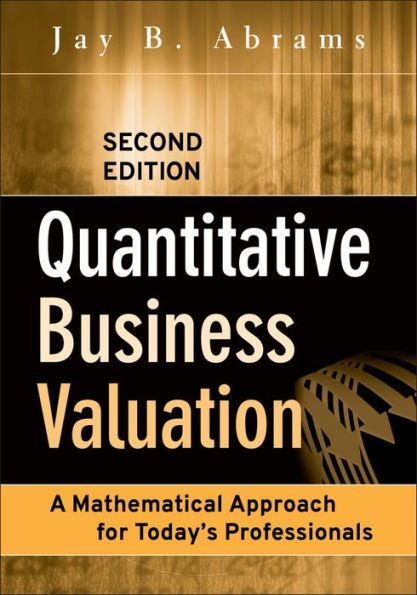Essential reading for the serious business appraiser, Quantitative Business Valuation, Second Edition is the definitive guide to quantitative measurements in the valuation process. No other book written on business valuation is as well researched, innovative, and bottom-line beneficial to you as a practitioner.
Written by leading valuation and litigation economist Jay B. Abrams, this text is a rigorous and eye-opening treatment filled with applications for a wide variety of scenarios in the valuation of your privately held business.
Substantially revised for greater clarity and logical flow, the Second Edition includes new coverage of:
- Converting forecast net income to forecast cash flow
- Damages in manufacturing firms
- Regressing scaled y-variables as a way to control for heteroscedasticity
- Mathematical derivation of the Price-to-Sales (PS) ratio
- Monte Carlo Simulation (MCS) and Real Options (RO) Analysis
- Venture capital and angel investor rates of return
- Lost inventory and lost profits damage formulas in litigation
Organized into seven sections, the first three parts of this book follow the chronological sequence of performing a discounted cash flow. The fourth part puts it all together, covering empirical testing of Abrams' valuation theory and measuring valuation uncertainty and error. Parts five to seven round it all out with discussion of litigation, valuing ESOPs and partnership buyouts, and probabilistic methods including valuing start-ups.
The resulting work, solidly grounded in economic theory and including all necessary mathematics, integrates existing science into the valuation profession—and develops valuation formulas and models that you will find useful on a daily basis.
Essential reading for the serious business appraiser, Quantitative Business Valuation, Second Edition is the definitive guide to quantitative measurements in the valuation process. No other book written on business valuation is as well researched, innovative, and bottom-line beneficial to you as a practitioner.
Written by leading valuation and litigation economist Jay B. Abrams, this text is a rigorous and eye-opening treatment filled with applications for a wide variety of scenarios in the valuation of your privately held business.
Substantially revised for greater clarity and logical flow, the Second Edition includes new coverage of:
- Converting forecast net income to forecast cash flow
- Damages in manufacturing firms
- Regressing scaled y-variables as a way to control for heteroscedasticity
- Mathematical derivation of the Price-to-Sales (PS) ratio
- Monte Carlo Simulation (MCS) and Real Options (RO) Analysis
- Venture capital and angel investor rates of return
- Lost inventory and lost profits damage formulas in litigation
Organized into seven sections, the first three parts of this book follow the chronological sequence of performing a discounted cash flow. The fourth part puts it all together, covering empirical testing of Abrams' valuation theory and measuring valuation uncertainty and error. Parts five to seven round it all out with discussion of litigation, valuing ESOPs and partnership buyouts, and probabilistic methods including valuing start-ups.
The resulting work, solidly grounded in economic theory and including all necessary mathematics, integrates existing science into the valuation profession—and develops valuation formulas and models that you will find useful on a daily basis.

Quantitative Business Valuation: A Mathematical Approach for Today's Professionals
672
Quantitative Business Valuation: A Mathematical Approach for Today's Professionals
672Related collections and offers

